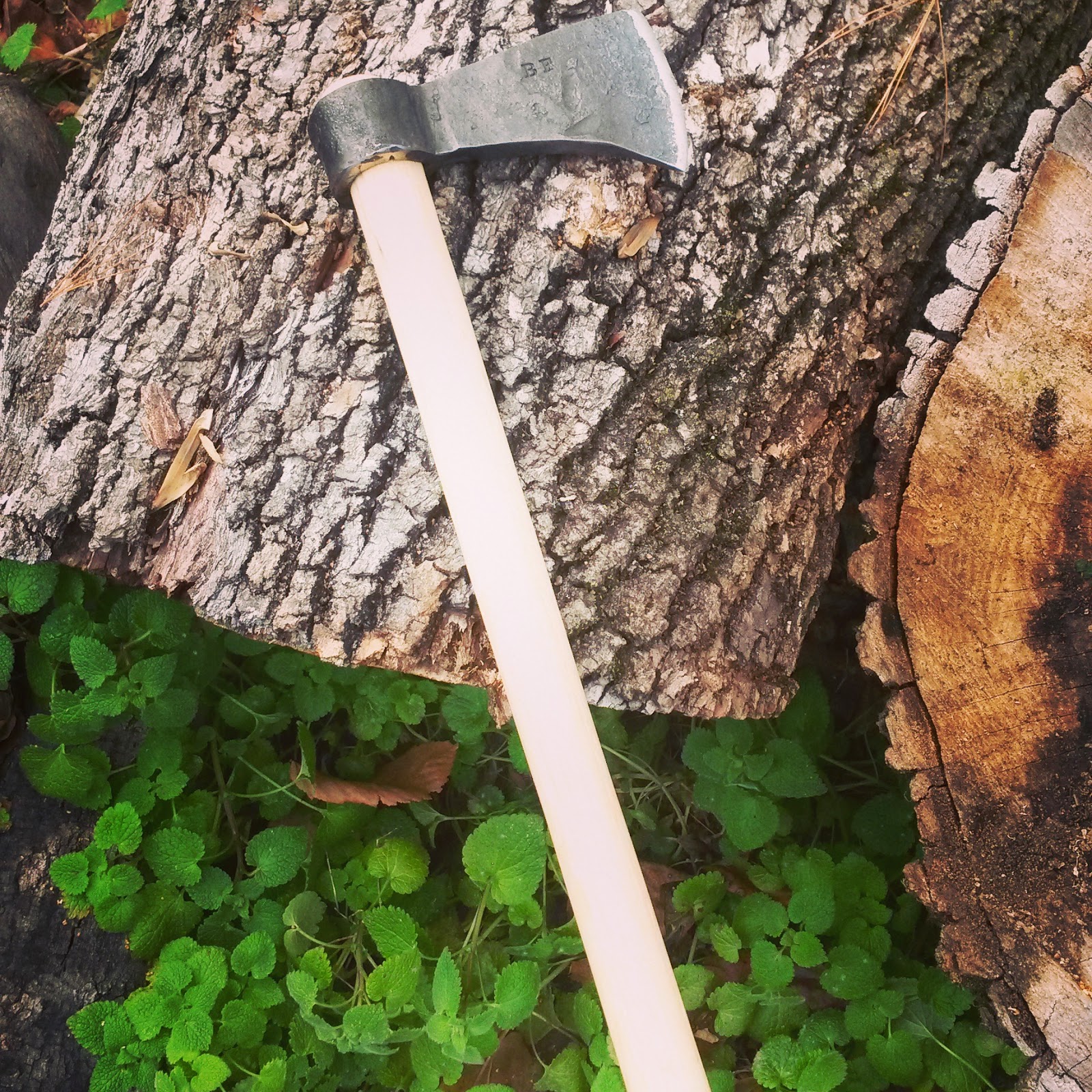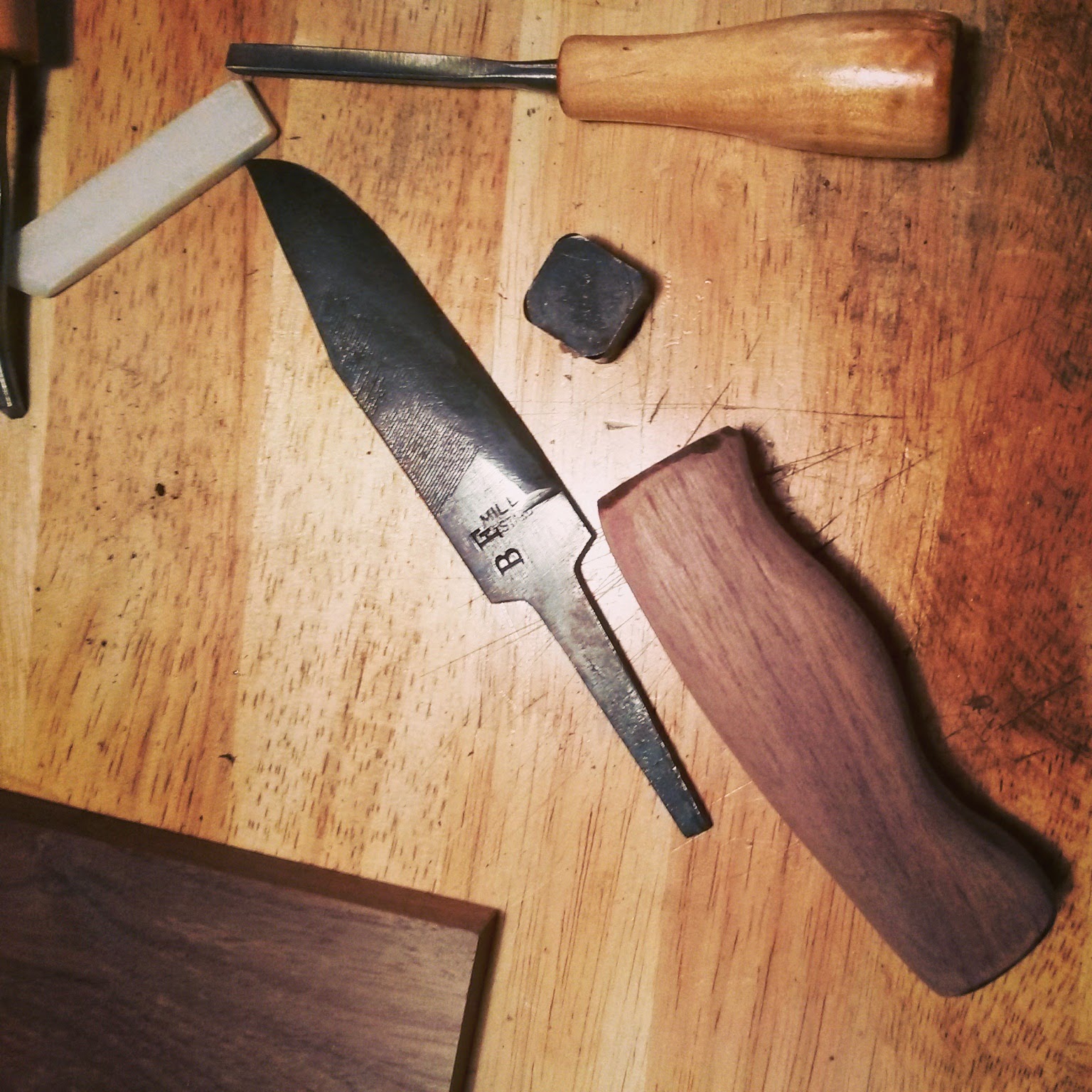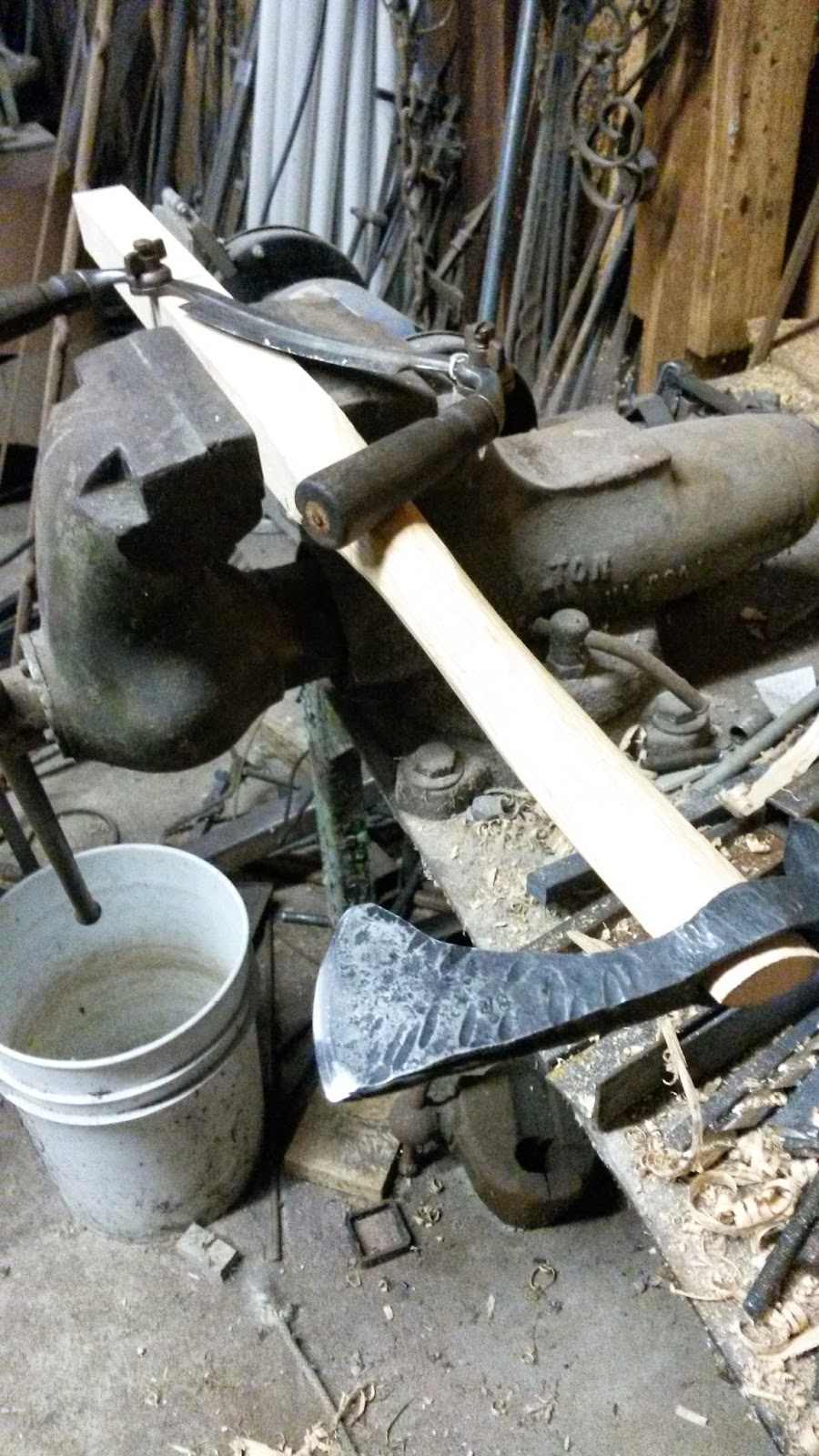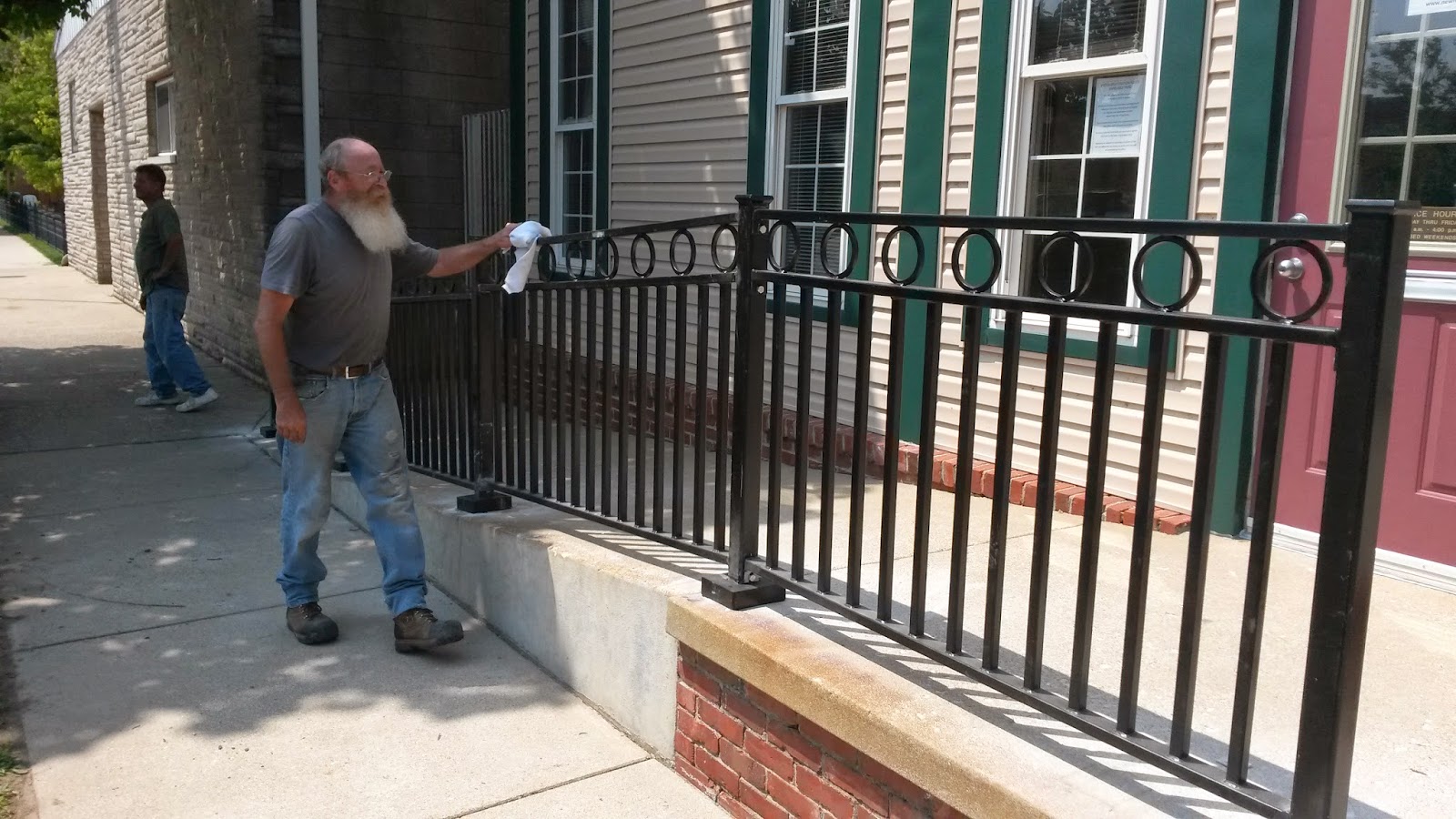I would like to start off by saying "WOW! What a busy past few weeks!"
If you're friends with or follow me on Facebook, I'm quite certain you've seen my spew of pictures from the events of the last few weeks. Here's what I'm going to do today. I'll tell you about the trip Wayne and I took to John C. Campbell in Brasstown, NC. I'll then tell you about throwing some of the hawks we made. Finally, I'll finish off with some talks of arrow heads and maybe, MAYBE a sneak peak of the next knife in the works for a good friend of mine. If you're not in the mood to do a lot of reading... save yourself now. This is a long one.
So, John C. Campbell.
 |
| ...I didn't want to leave this place. I mean, look at that view! |
I've had some time to think about this post. I needed time to think about this post because quite frankly I didn't know where to start. The weekend Wayne and I spent at John C. Campbell was much like the first weekend I spent in Cincinnati at a seminar for iaijutsu in the company great martial artists and a most awesome instructor. It was that same feeling of elation, not wanting the weekend to end, not wanting to leave. We had been prepping for weeks for this trip. I had been gathering supplies, conceptualizing what I was going to make, and stressing about the car drive down there. I was to soon find out that none of that was needed, none of it at all.

John C. Campbell Folk School is basically the most perfect adult camp you could imagine, set in the misty Appalachian Mountains of far western North Carolina. The school offers just about any type of craft class you can imagine. The place is extremely welcoming, everyone is nice, and my lord the food is amazing. Seriously, the second best part was the food. Everything about this place and the way it was set up made you converse and make connections with people. Realistically, it's a networking hot spot... it's awesome.
 |
| Look at that shop! ...And the beard! |
Wayne and I, of course, went for the blacksmithing class offered that weekend. It was a tomahawk and ax forging class taught by Ryan Johnson, who's president of RMJ Tactical (go ahead, look it up. You won't be disappointed). Ryan is a master and revolutionary of creating tomahawks and tactical breaching tools. Friday night after an awesome feast we headed down to the blacksmith shop. I think we spent the first 20 minutes of marveling at this shop. The place was impressive. There were 12 forges with alternating German and American style anvils, 5 power hammers, and a room FULL of hammers, tongs, hardies, chisels, and anything else you could imagine. We could have came to JCC with nothing and had everything we needed. There was a grinding and drilling room, which had two drill presses and 5 belt grinders, a welding corner with two Miller mig welders, and the front half of what I assumed to be the old blacksmith shop was full of all kinds of metal working machinery. It was just awesome, I can't say that enough. There was also the master forge, which had a beautiful copper and steel hood over it. The place was also timber framed, with each end of the timber rafters being carved into an anvil. For a blacksmith shop, the place was squeaky clean, far cleaner than our shop... but our messy shop reflects what goes on in our strange heads, I'm sure.
 |
| Ryan demonstrating the belt ax style. |
 |
| Elmer giving me some pointers on folding styles |
Ryan started the class by doing a demo of the hawk design we'd all be so diligently working towards all weekend. It was a folded style hawk, from 1 1/4 in x 1/4 in x 10 in mild steel with a chunk of 5160 truck spring stuck in between for the bit. Ryan did the first one by hand and then turned us loose at the forges. I was so excited I couldn't straight. We cut our stock and tore into our first hawk. Everything went dandy until my first forge weld. I couldn't get it to stick for the life of me. I gave it a yellow heat and smacked it, then tried again and again only to no avail. I couldn't get the sucker to weld. Finally, Elmer Roush came over and helped me. He let me know I just wasn't getting it hot enough. If you haven't heard of this guy, he's one of the top authorities on viking era blacksmithing (I've already signed up for his class in March, "Viking Era Blacksmithing"). With his watchful eye I was able to finally get my hawk to stick. This one took me quite a while, I did it all by hand, no power hammer. The next two... well I changed my method a bit for those.
 |
| Forge welding... having that beard was all it took! |
The next morning, after a haughty breakfast (why had I not had grits before? I'm hooked now!), I finished up the last few touches on my first hawk. Wayne was already welding his second hawk by now. This time, I decided, I was going to use one of the power hammers. I cut my stock, folded it, stuck the truck spring in it, and Wayne tacked it for me. Then, I gave it a good heat, fluxed it, more heat to a yellowish wet look, and then ran over to the tire hammer.
POW. POW. POW. POWPOWPOWPOWPOWPOW.
 |
| Wayne working the Little Giant 25lb power hammer |
The power hammer came down with all it's might, sending molten flux 20 feet in all directions. The hawk was welded. I learned something import here: If your hawk head has dropped to an orange heat, stop working. At that point, you're more likely to break your welds back apart. When working with welded material, work at a yellow heat. Besides, your metal moves better at that point. Anyway, I had to do a few more repair welds after sizing the eye more, then some grinding clean up and it was done.

After lunch (TACO SALAD!!), Ryan did a demo of a style of ax that Elmer usually does, a cool little Hudson Bay belt ax. Then, my buddy Will McAllister showed up from Bray Oaks Forge and helped me out quite a bit on some stuff. Between a little before dinner and the end of the night, will helped me get a nice weld, do some cool clean up and filing on the hawk head and handle, and then helped me pour a pewter cap on my handle. Will is super helpful and will find a way to answer any question you may have. If you haven't seen any of his work, look up Bray Oaks Forge on Facebook, you'll be in awe. He's moved over to more Viking style stuff lately, and all of his pieces are bad ass quite frankly. Many of them have pewter caps with wooden rune inlays or a nice hardwood handle polished to a sheen with silver inlay. The guys work is phenomenal, and as if I wasn't already lucky enough to be there learning from Ryan, Elmer, and Jack from Rustick Knives, I also got some help from Will. It was just too cool.
 |
| The ax that Will helped me on. What a beaut! |
Sunday was clean up time and "show and tell". Everyone displayed some of their work had lunch, and went home. We skipped lunch because we had a seven hour drive and wanted to make it home before dark. JCC was gorgeous, full of knowledge and good people, and worth every penny and every mile driven. I can't wait to go back in the spring.
 |
| Will McAllister of Bray Oaks forge and I |
 |
| Will, instructor Ryan Johnson, and I |
 |
| The ladies of the weekend. |
Now, some of the other things I've been working on.
I've been working on some arrowheads lately. I want to build my own arrows with my own custom arrowheads now that I've got a 71' English longbow that I love to shoot. The going is slow, because despite how easy you think arrowheads are to make, THEY'RE NOT. They require a lot of small detail work with lighter hammers that I'm not used to. It's fun for that reason, though. I have to do a lot of work that I'm not used to doing and that reveals many things I need to learn. I'll add some pictures of those once I get more forged.
Lastly, I'm working on a knife for an old co-worker of mine from back in the shoe-selling days. It's from a old mill file of the "Bastard" brand I think. It's going to be a nice little every day carry knife. I'm still polishing it and I'm on the fence whether to put a nice red oak handle on it or use some G10 or micarta that I just ordered. Don't worry, there will be pictures of this to come, too.
Thanks for taking the time to read this suuuuper long post. Y'all rock!
-Benton




























.jpg)



.jpg)





















